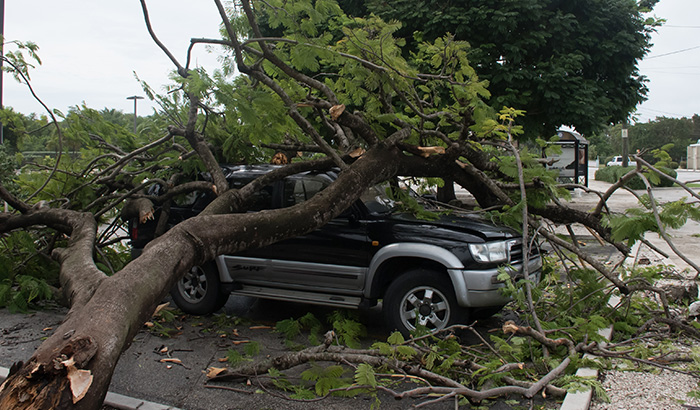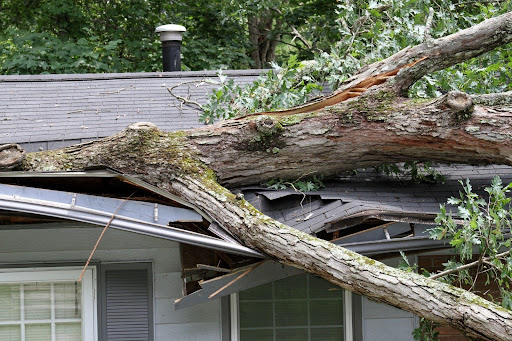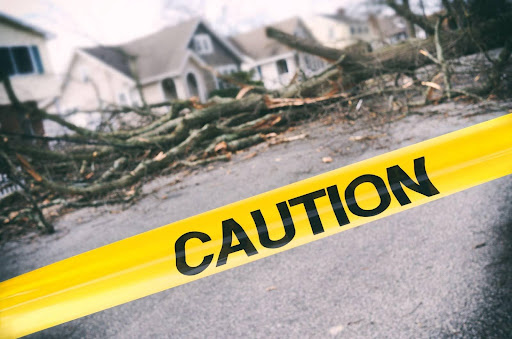Whether it’s a powerful windstorm, heavy rain, or hail, addressing storm damage promptly is essential for your safety and the well-being of your home.
In this guide, we’ll walk you through the vital steps to take if you find yourself facing storm damage. From assessing the extent of the damage to contacting your insurance provider and seeking professional help, we’ll provide you with the guidance you need to navigate the process effectively.
Assessing the damage
After a storm, it’s essential to promptly assess the damage to your property. Before you begin the assessment, prioritize safety. Check for any immediate hazards, like downed power lines, gas leaks, or unstable structures. If you come across any of these dangers, contact emergency services immediately and keep your distance.
Start by carefully inspecting your home and the surrounding area. Look for any visible signs of damage, such as missing roof shingles, broken windows, damaged siding, or fallen trees and debris.
Document the damage thoroughly. Take photographs of the affected areas and items. Make sure to capture the details. Also, write down descriptions of the damage, its location, and any visible structural issues. Remember to include the date on your documentation.
Ensuring safety first
Safety should be your top priority when you’re faced with storm damage. Act as quickly as possible if you suspect any problems with your utilities, like gas leaks, electrical issues, or water damage.
In the case of a gas leak, immediately turn off the gas supply at the main shutoff valve. Avoid using any electrical switches or open flames, and leave the area as quickly as possible. Reach out to your gas company or emergency services for immediate assistance.
If you notice standing water or damage to electrical systems, turn off the main circuit breaker or fuse box to prevent electrical hazards. However, if you’re uncomfortable doing this, it’s best to contact an electrician for professional assistance.
In case of water damage to your plumbing or a suspected water leak, turn off the main water supply to prevent further flooding. You can usually find the shutoff valve located near your water meter.
Following a storm, your property may have debris, fallen trees, and structural damage. Avoid these damaged areas until they’ve been properly assessed and secured. Refrain from walking under or near damaged trees and exercise caution around loose or hanging power lines.
If you come across situations that are beyond your expertise or involve hazardous materials, contact professionals who are experienced and equipped to handle such challenges safely and effectively.
Contacting your insurance provider
Once you’ve assessed the damage and ensured your safety, it’s time to initiate contact with your insurance provider. When you make the call, be prepared to provide your policy number, contact details, and a brief description of the damage. Your insurance company will then assign an adjuster to your case, and they will be responsible for evaluating the damage and guiding you through the claims process.
To streamline your claim, promptly provide all the required information and documentation. This typically includes:
- Damage description: Provide a comprehensive description of the damage. Be sure to include details about how the damage occurred, its extent, and any safety concerns you’ve identified.
- Photographs and documentation: Share any photographs and written documentation you’ve prepared during your damage assessment. Visual evidence plays a vital role in substantiating your claim.
- Personal information: Be ready to share your contact information, such as phone numbers and email addresses. Doing this allows the insurance company to reach you conveniently.
Before you initiate the claims process, take the time to understand your insurance coverage and deductible. Your policy will outline the specific types of damage covered, coverage limits, and any deductibles you might be responsible for.
If you have any questions or uncertainties about your coverage, don’t hesitate to contact your insurance company for clarification.
Temporary repairs
After a storm has damaged your property, it’s crucial to act swiftly to prevent further damage. Here, we’ll discuss the steps you can take to address immediate concerns and perform temporary repairs. These actions aim to safeguard your home while you prepare for more permanent solutions.
Addressing immediate issues to prevent further damage:
- Leaking Roof: If your roof is leaking, it may lead to water damage inside your home. Place containers or buckets under the leaks to catch dripping water to prevent this. To minimize further water infiltration, safely cover the damaged area with a tarp or heavy-duty plastic sheeting.
- Broken Windows: Broken windows are not only a security risk but also allow rain and debris to enter your home. Use strong adhesive tape or boards to cover the broken windows temporarily. This will help keep your interior dry and secure.
- Flooded Basement: Dealing with a flooded basement requires prompt action to prevent further damage. Remove standing water from the area by using a submersible pump. Alternatively, a wet/dry vacuum can be effective for smaller-scale water extraction.
Temporary fixes for common storm damage scenarios
- Temporary Roof Patch: If your roof has sustained damage, consider using a roof patching kit. These kits typically contain sealant and patches that you can apply to stop leaks temporarily. They serve as an effective stopgap measure until you can get professional repairs.
- Tree Limb Removal: Fallen tree limbs can cause additional damage and pose a safety hazard. Carefully remove them to prevent further destruction. Ensure you have the necessary tools and take safety precautions when dealing with branches.
- Secure Loose Siding or Shingles: Loose or partially detached siding and shingles expose your home to the elements. Temporarily secure them with nails or screws until permanent repairs can be arranged.
- Temporary Window Coverings: Shattered windows need immediate attention. Cover the broken areas with plastic sheeting or a tarp to keep out rain and debris. Doing this will preserve the integrity of your interior until proper repairs can be made.
Keep in mind that these temporary repairs are short-term solutions to address immediate concerns. It’s essential to follow up with professional repairs and inspections to ensure the long-term stability of your home.
Hiring professional restoration services
Seeking the assistance of professional restoration services makes a world of difference. In this section, we’ll explore why turning to experts is a wise decision, provide guidance on selecting a trustworthy restoration company, and offer insights into what to expect during the restoration process.
The benefits of professional restoration:
- Expertise and experience: Restoration experts bring a wealth of knowledge and hands-on experience to the table. They have a deep understanding of storm damage, including structural issues, water damage, and the potential for mold growth. This expertise allows them to assess the situation accurately and plan effective solutions.
- Efficiency: Professional restoration teams work swiftly to minimize further damage and kickstart the recovery process. They have access to specialized equipment and techniques that can speed up repairs, ensuring that your property is back to its pre-damage condition as soon as possible.
- Safety first: Dealing with storm damage can be risky, with hazards like unstable structures or electrical issues. Restoration professionals know how to go about repairs safely and avoid unnecessary risks.
How to choose a trustworthy restoration company
When choosing a restoration company, research local businesses and check their reputation through online reviews and testimonials. Verify their credentials, including licenses and certifications, to ensure adherence to industry standards.
You’ll also want to confirm their insurance coverage for your protection and request detailed estimates to make an informed decision.
What to expect during the restoration process
- Comprehensive assessment: The restoration process typically begins with a comprehensive assessment of the damage. Restoration experts will identify structural issues, water damage, and potential safety hazards.
- Tailored plan: Based on the assessment, restoration professionals develop a customized restoration plan. This plan outlines the steps required to restore your property to its pre-damage condition.
- Skilled execution: The restoration team will then carry out the plan, making repairs, addressing water damage, and taking measures to prevent mold growth. They use specialized equipment and techniques to expedite the restoration work.
- Ongoing communication: Expect regular communication from the restoration company throughout the process. They should keep you updated on progress, any adjustments to the plan, and estimated completion times.
- Final inspection: Once the restoration work is finished, a final inspection ensures that everything meets the established standards. You’ll have an opportunity to review the results and address any remaining concerns.
Weather any storm with Total Flood & Fire
For prompt and professional storm damage recovery, reach out to Total Flood & Fire Restoration. Our team of experts possesses the expertise and equipment required for safe and effective property restoration.
Through initial inspection, debris removal, water extraction, drying, structural repairs, mold remediation, cleaning and restoration, and insurance assistance, Total Flood & Fire is there with you at each step of the restoration process.
Contact Total Flood & Fire at 385-483-2109 or online to discover more about our storm damage restoration services and schedule a consultation.









